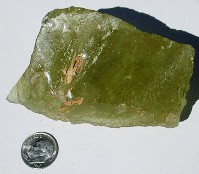Darwin Glass

It seems appropriate that a very detailed description and explanation for Darwin Glass has appeared in the centenary year of Charles Darwin, though his only connection with the occurrence is the eponymous mountain in Tasmania. McCall
1 covered what was known up to 2000 about Libyan Desert Glass and Darwin Glass. He noted that a 1.2 km diameter crater had been discovered by Ford
2 in 1972, immediately on the eastern boundary of the strewn field, and discounted the suggestion that this could be the source of the Australasian tektite strewn field, the age and chemistry being wrong, and the occurrence at the distal end of that huge strewn field.
Howard3 dates the crater at 800 Ka and finds that glass was ejected to up to 20 km from the crater, the strewn field to the west covering >400km2. At least 11,250m
3 of glass was ejected, the most abundant known ejection of glass relative to the impact crater size on Earth. The glass includes irregular and splashform glass, the latter ropy, spheroid, elongate and droplet in form; three quarters irregular: colours are green black and white. White glasses contain up to 92% silica by weight; and formed by melting quartzite: black glasses contain 76% silica and formed from shale. The latter resemble tektites in their composition, the former resemble the Libyan glass and glass associated with the Wabar crater, Arabia1. Irregular masses range from a few millimetres diameter to 15 X 8cm in size. Splashforms are mostly ropy, rod-like and up to 40 mm in length. Ballistic ejection is consistent with largest fragments being deposited close to the crater. The continuous distribution does not require the removal of the atmosphere by an expanding vapour plume as in the jetting theory for tektites
4. These glass masses should not be regarded as tektites. Atmospheric blow-out is restricted to much larger-scale impacts. The shale sourced glass is distributed further than that quartzite-sourced. The huge abundance of this glass associated with a relatively small crater is not due to high volatility or porosity of the target sediments, as the volatile content and porosity is low.
Similar glass was recorded in 1920 at Mt. Macedon, Victoria, on the mainland
1. Museum mislabelling has been discounted and it seems likely that some Darwin Glass reached a point 560 km, slightly west of north from the Mt. Darwin crater. This Mt. Darwin occurrence remains unique, on a par with the remarkable Tunguska event in Siberia, in 1908
1. Both may well have been caused by impact of rare bodies from Space, not the usual run of meteorites and asteroids. The Mt. Darwin event seems consistent with impact at an immense velocity, compared with the Wolfe Creek or Henbury events
1 which produced craters of similar size associated only with a few scattered iron meteorite masses? .
- McCall, G.J.H. 2001. Tektites in the Meteorite Record; Showers of Glass from the Sky. Geological Society, London, 256pp.
- Ford, R.J. 1972. A possible impact crater associated with Darwin Glass. Earth & Planetary Science Letters 16; 228-230
- oward, K.T. 2009. Physical distribution trends in Darwin Glass. Meteoritics & Planetary Science 44(1); 115-129
- Melosh, H.J. 1989. Impact cratering: A geological process. Oxford University Press: New York, 245 pp.
Illustration taken from
"Collector's Corner" by Mark Bostick (c) Mark Bostick.